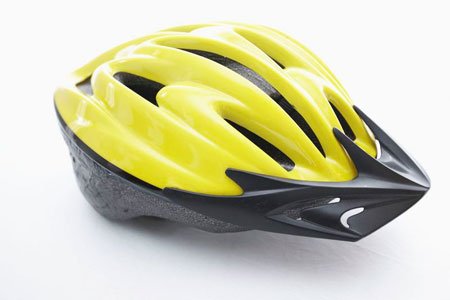The safest way for students to use their bikes is for transportation, not play. While this advice may surprise you, it comes from the Nemours Foundation, one of the world’s largest philanthropic organizations devoted to the health and well being of children. Bike riding can be a lot fun, but make no mistake bicycles are not toys. It is critically important that your son or daughter understands the importance of practicing basic bicycle safety.
“Every year, about 300,000 kids go to the emergency department because of bike injuries. Some of these injuries are so serious that children die, usually from head injuries.” These statistics supports the National Safety Council’s directive: “Students should always wear a helmet, even for a short ride.” The council’s research indicates traumatic head injuries can be prevented or less severe when a properly fitting helmet is worn.
The Consumer Product Safety Commissions (CPSC) offers excellent guidance on selecting and wearing a helmet. Bike helmet are so critical to your child’s well being, the U.S. government created safety standards for them. When purchasing a helmet, parents should look for a CPSC sticker. It is also recommended to remind your child a helmet will provide some protection for the face, head, and brain in case of a fall. However, it does not mean they should ride recklessly.
“A bike helmet should fit you properly,” says the CPSC. “You don’t want it too small or too big. Never wear a hat under a bike helmet. If you’re unsure if your helmet fits you well, ask someone at a bike store. Once you have the right helmet, you need to wear it the right way so it will protect you. It should be worn level and cover your forehead. Don’t tip it back so your forehead is showing.
The straps should always be fastened. If the straps are flying, it’s likely to fall off your head when you need it most. Make sure the straps are adjusted so they’re snug enough that you can’t pull or twist the helmet around on your head. Take care of your bike helmet and don’t throw it around. That could damage the helmet and it won’t protect you as well when you really need it. They don’t work as well after a major crash.”
Children who regularly ride a bike to and from school must at all times be careful to avoid an accident. In addition to looking both ways when entering traffic, obeying traffic signals and wearing reflective clothing, children must remember to always ride with attention to their surroundings. For example, a student running late may abandon their usual caution. Remind your child it’s better to be late than involved in a collision with a moving motor vehicle.
If your child rides a bus to school, you’ll be pleased to know “School buses are one of the safest forms of transportation on the road today. In fact, according to the National Highway Traffic Safety Administration, riding a bus to school is 13 times safer than riding in a passenger vehicle and 10 times safer than walking to school.
The reality of school bus safety is that more children are hurt outside the bus than inside as passengers. Most of the children who lose their lives in bus-related crashes are pedestrians, four to seven years old hit by the bus or by motorists illegally passing a stopped school bus. For this reason, it is necessary to know the proper laws and procedures for sharing the road safely with school buses.
All 50 states have a law making it illegal to pass a school bus that is stopped to load or unload children. Traffic in both directions is required to stop. School buses use yellow flashing lights to alert motorists that they are preparing to stop to load or unload children. Red flashing lights and an extended stop sign arm signals to motorists that the bus is stopped and children are getting on or off the bus.
Be alert! Children are unpredictable. Students walking to or from their bus are usually very comfortable with their surroundings. This makes them more likely to take risks, ignore hazards or fail to look both ways when crossing the street. Never pass a school bus on the right.”
Jayne Matthews Hopson writes about education matters because “only the educated are free.”
